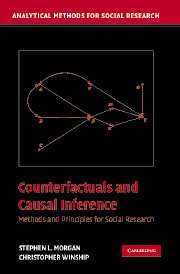Book contents
- Frontmatter
- Contents
- Acknowledgments
- Part 1 Counterfactual Causality and Empirical Research in the Social Sciences
- Part 2 Estimating Causal Effects by Conditioning
- Part 3 Estimating Causal Effects When Simple Conditioning Is Ineffective
- 6 Identification in the Absence of a Complete Model of Causal Exposure
- 7 Instrumental Variable Estimators of Causal Effects
- 8 Mechanisms and Causal Explanation
- 9 Repeated Observations and the Estimation of Causal Effects
- Part 4 Conclusions
- References
- Index
6 - Identification in the Absence of a Complete Model of Causal Exposure
Published online by Cambridge University Press: 05 June 2012
- Frontmatter
- Contents
- Acknowledgments
- Part 1 Counterfactual Causality and Empirical Research in the Social Sciences
- Part 2 Estimating Causal Effects by Conditioning
- Part 3 Estimating Causal Effects When Simple Conditioning Is Ineffective
- 6 Identification in the Absence of a Complete Model of Causal Exposure
- 7 Instrumental Variable Estimators of Causal Effects
- 8 Mechanisms and Causal Explanation
- 9 Repeated Observations and the Estimation of Causal Effects
- Part 4 Conclusions
- References
- Index
Summary
In this chapter, we introduce strategies to estimate causal effects when simple conditioning methods will not suffice. After reviewing the related concepts of a nonignorable treatment assignment and selection on the unobservables, we then consider sensitivity analysis and partial identification approaches. Thereafter, we introduce three strategies to identify and then estimate causal effects: (1) conditioning on a prior value of the observed outcome variable, (2) using an instrumental variable (IV) for the causal variable, and (3) estimating an isolated and exhaustive mechanism (or set of mechanisms) that relates the causal variable to the outcome variable. Under very specific assumptions, these strategies will identify a specific average causal effect of interest even though selection is on the unobservables and treatment assignment is nonignorable. These strategies are then explained more completely in the following three chapters, where the specific details of estimation are laid out.
Nonignorability and Selection on the Unobservables Revisited
As demonstrated earlier in Subsections 3.2.1 and 3.2.2, the concept of ignorable treatment assignment is closely related to the concept of selection on the observables. In many cases, they can both be represented by the same causal graph.
- Type
- Chapter
- Information
- Counterfactuals and Causal InferenceMethods and Principles for Social Research, pp. 169 - 186Publisher: Cambridge University PressPrint publication year: 2007

